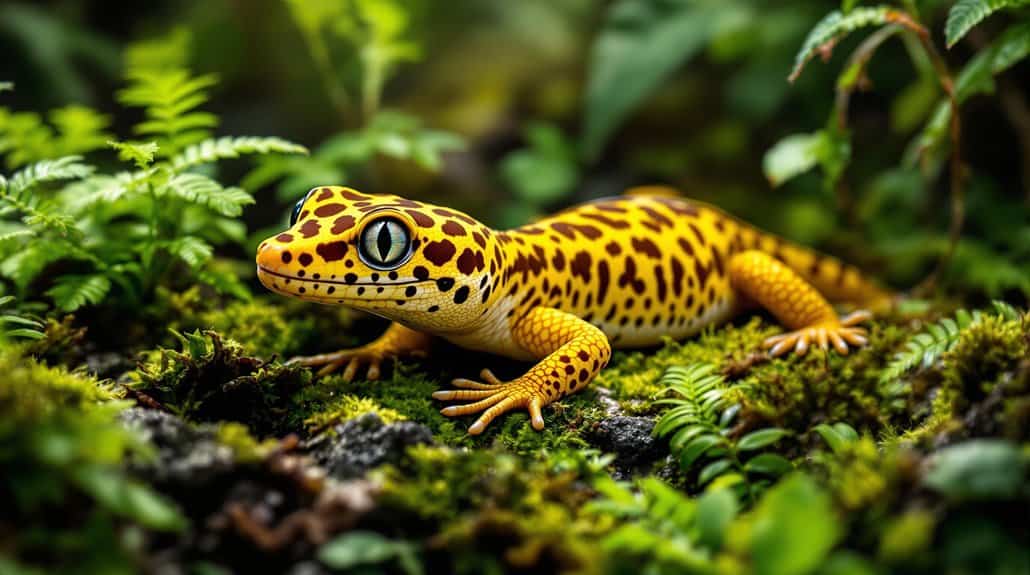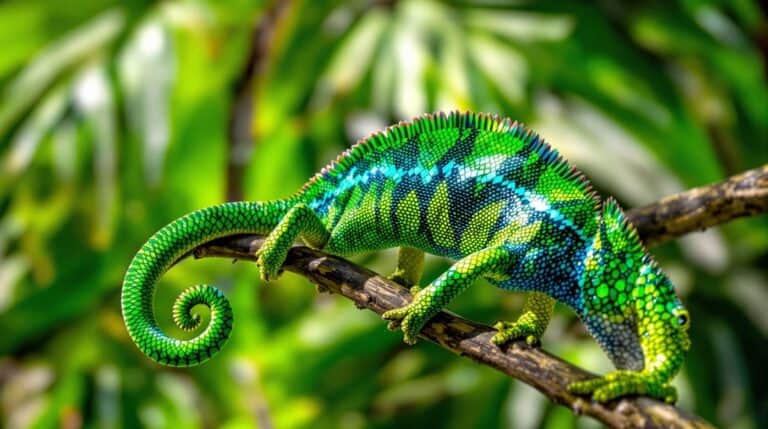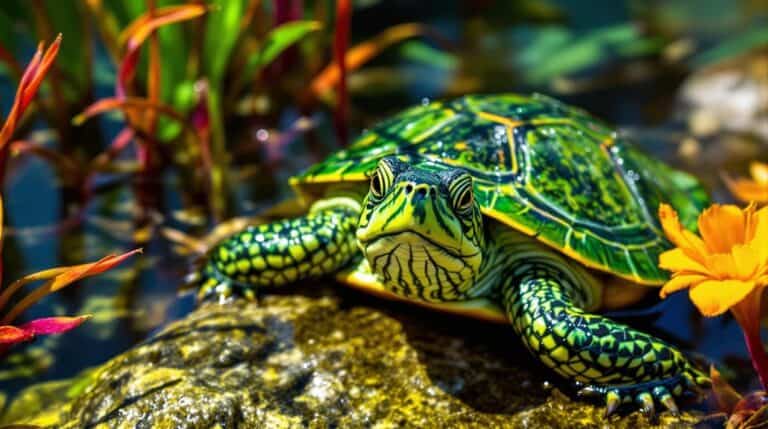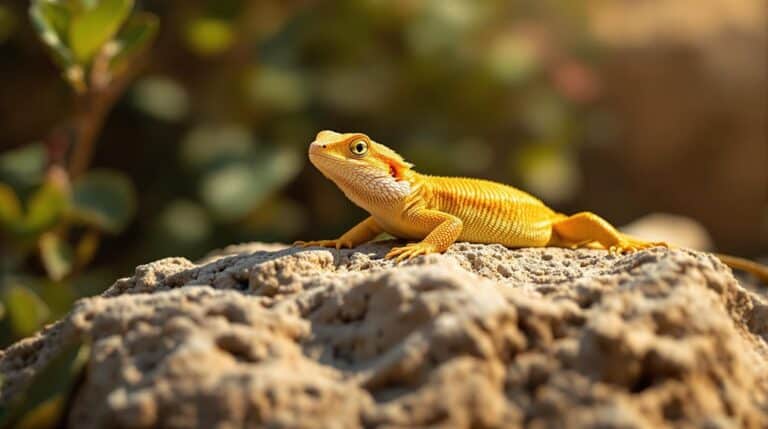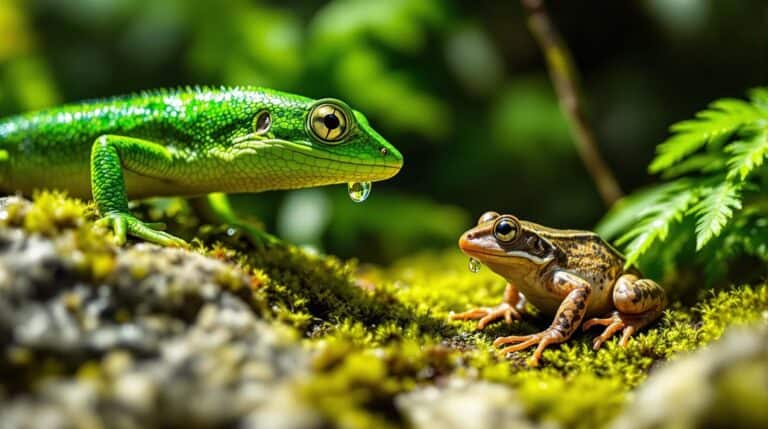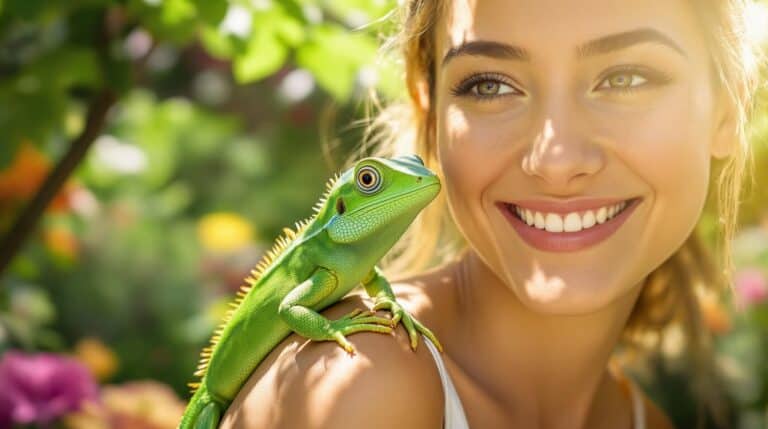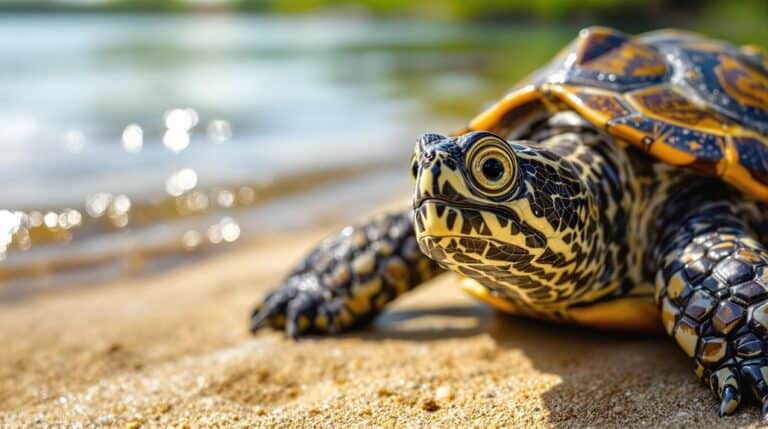Leopard Gecko Jungle Morph
The Leopard Gecko Jungle Morph is like a vibrant quilt bursting with colors and patterns! Developed in 1991, these beauties show off yellows, browns, and greys, often resembling psychedelic art. What’s super cool is that their unique spots and stripes can surprise you; sometimes you only see their wild patterns as they grow! Breeding these geckos is a fun puzzle, with genetic surprises around every corner, making each hatchling special. Caring for them is a blast too, as they need just the right cozy setup. If you’re curious about their crazy patterns and colorful personalities, there’s so much more to discover!
Table of Contents
Key Takeaways
- The Jungle Morph is a visually striking leopard gecko known for its vibrant colors and unique patterns, developed by Ron Tremper in 1991.
- Breeding Jungle Morphs involves complex genetics, with polygenic and recessive traits leading to unpredictable but exciting offspring patterns.
- Hatchlings may not reveal their full patterns until maturity, adding an element of surprise to breeding outcomes.
- Proper care includes a spacious enclosure, specific heating requirements, and a diet of live insects dusted with vitamins and calcium.
- Maintaining genetic diversity is crucial to prevent health issues, as over 100 morphs exist to promote varied traits among leopard geckos.
Definition and Characteristics

When I think of the Leopard Gecko Jungle Morph, the first thing that comes to mind is its stunning and unpredictable beauty. These little creatures have a jungle history that’s as wild as they are! Developed by Ron Tremper in 1991, every jungle leo tells a unique story. Their genetic nature is a mix of polygenic and recessive traits, making them a bit like a surprise party—some traits are hidden, waiting to pop up when you least expect it! The genetic complexity of these geckos leads to varied outcomes in breeding, adding to the excitement.
Breeding these beauties can be quite the adventure. You never quite know what you’ll get, and that’s part of the fun! Some hatchlings don’t show their jungle patterns until they grow up, which keeps us on our toes. Isn’t that exciting? Plus, the rarity of these geckos makes them even more special. Each one is a unique work of art, with patterns that can include spots, stripes, or even fancy tail designs! This breeding challenge adds to their allure and makes them a prized possession among collectors.
Visual Appearance
The visual appearance of the Leopard Gecko Jungle Morph is truly enchanting, showcasing a blend of unpredictability and beauty. When you look at one, you can’t help but feel excitement! The color pattern is a delightful mix, often featuring yellows, browns, and greys that swirl together in a slightly psychedelic way. Imagine a splash of paint on a canvas—each gecko is like a unique masterpiece! The intricate contrasts and swirls in their patterns make them a living work of art, captivating reptile enthusiasts and casual observers alike. To truly appreciate their stunning features, a proper leopard gecko lighting setup is essential, as it highlights their vibrant colors and intricate details. With the right lighting, their patterned skin seems to glow, allowing their uniqueness to shine even brighter in any environment.
What’s really cool is how the patterns can vary so much. Some may have broken or incomplete bands, while others might not have bands on their tails at all! It’s like a surprise party for your eyes! As geckos grow, their patterns often become clearer, making them even more stunning. Plus, they can mix with other morphs, adding even more visual diversity. Additionally, this morph can have unique combinations due to the genetic diversity in breeding practices. Interestingly, the Jungle Morph can also display traits from common morphs like the Stripe, resulting in striking visual combinations.
However, spotting the differences can be tricky, especially with hatchlings. It’s like trying to find Waldo in a colorful crowd! But once you get to know these little creatures, their charm and character shine through. So, embrace the wonder! The Leopard Gecko Jungle Morph is not just a pet; it’s a vibrant piece of nature art waiting to brighten your life!
Comparison With Other Morphs

Comparing the Leopard Gecko Jungle Morph with other morphs reveals fascinating differences that can help you appreciate their unique traits even more. You’ve got to love how Jungle traits showcase their wild side! Here’s what sets them apart:
- Unique Patterns: No two Jungle geckos look alike, thanks to their wild patterning!
- Tail Differences: Their tails often sport broken or absent bands, which is a real standout feature.
- Genetic Complexity: Jungle morphs are polygenic, making their morph genetics a thrilling puzzle. Trait inheritance involves multiple genes, complicating breeding outcomes. Additionally, significant changes in appearance are often noted within the first year, showcasing their color maturation process.
- Color Variations: While some morphs, like Tangerine, flaunt vibrant colors, Jungles keep it mysterious with their intricate patterns.
- Aberrant Comparisons: Aberrant morphs may have broken patterns too, but they don’t extend to the tail like the Jungle.
When you explore pattern analysis, it’s clear that Jungle geckos bring a special flair to the table. Their unpredictability adds to their charm, making them a delightful choice for any enthusiast. So, whether you’re a seasoned pro or a newbie, the Jungle morph offers something truly special in the vivid world of leopard geckos!
Breeding and Genetics
Breeding and genetics play an essential role in developing the Leopard Gecko Jungle Morph. It’s like a wild game of genetic hide-and-seek! You see, these geckos are polygenic, which means multiple genes are at play, and they can be a bit sneaky with their traits. Sometimes, a parent might seem ordinary, but they’re secretly carrying the jungle magic to pass on to their babies. Talk about a surprise party!
When it comes to mating practices, patience is key. Not every pairing will produce a jungle gem. Some offspring might show off those gorgeous broken bands, while others might look totally different. That’s the beauty of it—a unique little jungle crew! Additionally, understanding recessive traits is crucial since not all desired characteristics will be visible in parent geckos. It’s also important to note that females typically lay eggs in pairs, producing an average of five clutches per year, which allows for multiple opportunities to refine your breeding goals.
Keeping detailed records is like being a gecko detective. You’ll want to track who’s who in your breeding program to understand trait inheritance better. Remember, it’s not just about genetics; selection matters, too! So, be smart about your choices—pick your breeders wisely. With a mix of science and a sprinkle of luck, you can create the stunning Leopard Gecko Jungle Morph you’ve been dreaming of!
Care and Health

When it comes to caring for a Leopard Gecko Jungle Morph, ensuring the right environment is essential for their overall health and well-being. These little guys are super easy to care for, and you’ll love setting up their habitat! Here’s what you need to keep in mind for their habitat setup and diet requirements:
- Enclosure Size: A minimum of 3 x 2 x 2 feet for adults is perfect.
- Heating: Create a thermal gradient with a basking spot of 90°F and a cooler area around 70°F.
- Lighting: Low-level UVB lighting helps keep them healthy and happy.
- Humidity: Aim for 30-40% humidity and provide a humid hide for shedding.
- Diet: Feed them live insects like crickets and dubia roaches, dusted with calcium and vitamins! Leopard geckos are carnivorous, primarily consuming insects for their diet. Additionally, it’s important to ensure that their habitat has adequate hiding spots to reduce stress and promote a sense of security.
Keep a close eye on their eyes and skin; they should be bright and clear. Regular cleaning is a must, and remember to give them fresh water daily. You’ll be amazed at how quickly they become a part of your life. With love and care, your gecko will thrive!
Popularity and Availability
Leopard Gecko Jungle Morphs have gained immense popularity among reptile enthusiasts, and it’s easy to see why. These stunning creatures flaunt an array of colorful patterns, making them the eye candy of the reptile kingdom! With their rarity and breeding challenges, they’ve become a must-have for serious collectors. Just picture a vibrant jungle morph gracing your home—who wouldn’t want that?
Here’s a peek into the qualities that make jungle morphs so desirable:
| Feature | Impact |
|---|---|
| Diverse Patterns | Captivates collectors’ hearts |
| Breeding Challenges | Adds to their allure |
| High Market Demand | Prices can skyrocket! |
| Unique Characteristics | Essential for expert collectors |
| Continuous Evolution | Keeps the excitement alive! |
These morphs are not just reptiles; they’re a symbol of freedom, creativity, and the wild! The market trends show that as more new morphs are developed, understanding genetics keeps breeders striving for unique traits, and demand keeps climbing. Additionally, proper habitat conditions—such as maintaining humidity—are essential for their health and well-being. Whether you’re a collector or just dreaming about one, jungle morphs are here to stay, ready to bring a splash of adventure into your life! So, are you ready to join the jungle party?
Unique Patterns and Variability

There’s something truly enchanting about the unique patterns and variability found in Jungle Morphs. Each one is like a little masterpiece of nature, bursting with personality and flair! When I look at these geckos, I can’t help but admire their pattern uniqueness. Here are some cool features that make them stand out:
- Irregular Bands: Their bodies show off broken or incomplete bands.
- Diagonal Stripes: Some have funky diagonal stripes, rare in other morphs!
- Swirly Patterns: You’ll find swirls that look slightly psychedelic—so groovy!
- Tail Patterns: Their tails often have broken bands, adding to their charm.
- Unique Variations: No two jungle leos are alike, making each one special.
These variability factors create a kaleidoscope of colors and designs, from Four-Eyed Jungles to Jungle Albinos. It’s like having a tiny, colorful treasure in your hands. The Jungle mutation showcases a vibrant aesthetic that captivates both enthusiasts and newcomers alike. Whether you’re a seasoned enthusiast or a newbie, you’ll find joy in exploring these fascinating creatures. So, let’s celebrate the wild, wonderful world of Jungle Morphs together! Who wouldn’t want to own a piece of this colorful, patterned magic?
Genetic Complexity Explained
Understanding the genetic complexity of Jungle Morphs can feel like unraveling a fascinating puzzle. These little wonders are a whirlwind of traits, and their inheritance patterns are anything but straightforward. It’s like trying to predict the weather in a jungle—unpredictable!
Here’s a peek into their genetic makeup:
| Aspect | Details |
|---|---|
| Mutation Type | Involves multiple genetic mutations |
| Inheritance Pattern | Unpredictable, sometimes incomplete recessive |
| Breeding Surprise | Non-Jungle parents can produce Jungle offspring |
| Pattern Variability | No two Jungles look exactly alike! |
Breeding Jungle Morphs requires patience and a bit of magic! Sometimes, you’ll get hatchlings that don’t show their pattern until they’re grown. How wild is that? And even geckos that seem to have the Jungle trait might surprise you by not displaying it. It’s a game of genetics, where selection plays a big part. Additionally, understanding genetic inheritance patterns is essential for predicting the traits of future offspring. In fact, breeders must possess thorough genetic knowledge to navigate these unpredictable outcomes effectively.
Tips for Breeders

Breeding Jungle Morphs can be a rewarding yet challenging experience, given their complex genetic traits. If you’re diving into this colorful world, here are some tips to help you navigate the adventure with flair!
- Know the Genetics: Since jungle traits are polygenic and sometimes recessive, understanding the genetic testing can clarify your breeding strategies. Common morph types can help you identify potential traits in your breeding pairs.
- Patience is Key: Don’t be surprised if you don’t see those wild patterns until your hatchlings are grown. It’s like waiting for a surprise party!
- Mix It Up: Experiment with hybrid varieties, combining jungles with other morphs. You might just create the next big sensation!
- Identify Patterns: Keep an eye out for unique tail patterns and irregular designs. No two jungles are alike, making each one a special gem.
- Stay Flexible: Since these traits can behave unpredictably, be ready to adapt your breeding strategies as you learn.
Breeding Jungle Morphs can be a thrilling ride. Enjoy the journey, embrace the surprises, and remember, every gecko you create adds to the tapestry of this enchanting hobby! Happy breeding!
Maintaining Genetic Diversity
While it’s tempting to focus solely on producing striking appearances in leopard geckos, maintaining genetic diversity is just as vital for ensuring healthy and vibrant populations. Think of it like making a smoothie; if you only use bananas, it’s just a banana mush! We need a mix of fruits for the best flavor and health benefits. Additionally, with over 100 different morphs in existence, careful breeding practices that prioritize genetic diversity can lead to more robust and varied offspring.
Inbreeding risks can sneak up on us if we’re not careful. Too much of the same gene pool can lead to health issues and genetic disorders. Yikes! That’s why practicing good genetic management is imperative. It helps us dodge those nasty inherited diseases and keeps our geckos bouncing around happily.
Conclusion
So, whether you’re captivated by the jungle morph’s vibrant colors or the cool patterns that make each gecko unique, there’s no denying their charm! Just like a treasure hunt, breeding these little guys can be tricky but super rewarding. Remember, maintaining genetic diversity is like mixing up your favorite ice cream flavors—it’s what keeps things exciting! So go ahead, plunge into the world of leopard geckos, and let the adventure begin!

